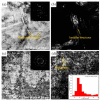Peening Techniques for Surface Modification: Processes, Properties, and Applications
- PMID: 34300760
- PMCID: PMC8307355
- DOI: 10.3390/ma14143841
Peening Techniques for Surface Modification: Processes, Properties, and Applications
Abstract
Surface modification methods have been applied to metals and alloys to change the surface integrity, obtain superior mechanical properties, and improve service life irrespective of the field of application. In this review paper, current state-of-the-art of peening techniques are demonstrated. More specifically, classical and advanced shot peening (SP), ultrasonic impact peening (UIP), and laser shock peening (LSP) have been discussed. The effect of these techniques on mechanical properties, such as hardness, wear resistance, fatigue life, surface roughness, and corrosion resistance of various metals and alloys, are discussed. This study also reports the comparisons, advantages, challenges, and potential applications of these processes.
Keywords: fatigue life; laser shock peening; microstructure; severe plastic deformation; shot peening; ultrasonic impact peening.
Conflict of interest statement
The authors declare no conflict of interest. The funders had no role in the design of the study; in the collection, analyses, or interpretation of data; in the writing of the manuscript, or in the decision to publish the results.
Figures























References
-
- Azhari A., Sulaiman S., Rao A.K.P. A review on the application of peening processes for surface treatment. IOP Conf. Ser. Mater. Sci. Eng. 2016;114 doi: 10.1088/1757-899X/114/1/012002. - DOI
-
- Nagarajan B., Kumar D., Fan Z., Castagne S. Effect of deep cold rolling on mechanical properties and microstructure of nickel-based superalloys. Mater. Sci. Eng. A. 2018;728:196–207. doi: 10.1016/j.msea.2018.05.005. - DOI
-
- Tao N.R., Wang Z.B., Tong W.P., Sui M.L., Lu J., Lu K. An investigation of surface nanocrystallization mechanism in Fe induced by surface mechanical attrition treatment. Acta Mater. 2002;50:4603–4616. doi: 10.1016/S1359-6454(02)00310-5. - DOI
-
- Kovacı H., Yetim A.F., Baran Ö., Çelik A. Tribological behavior of DLC films and duplex ceramic coatings under different sliding conditions. Ceram. Int. 2018;44:7151–7158. doi: 10.1016/j.ceramint.2018.01.158. - DOI
-
- Lowe T.C., Valiev R.Z. The use of severe plastic deformation techniques in grain refinement. JOM. 2004;56:64–68. doi: 10.1007/s11837-004-0295-z. - DOI
Publication types
Grants and funding
LinkOut - more resources
Full Text Sources

